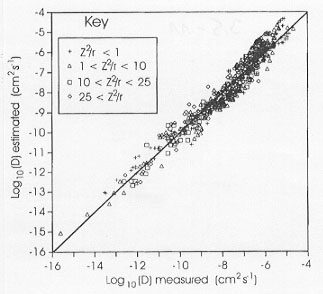

Diffusion of ions in silicate melts underlies all melt processes that involve heterogeneous reactions, providing the physical mechanism through which matter can be transferred to interfaces between phases. Examples of igneous processes mediated by diffusion include crystal growth and dissolution, bubble formation and growth, magma mixing and multicomponent gravitational instability. Similar processes are of interest in the glass industry and in the treatment of nuclear waste. Here we demonstrate a simple relation between viscosity and tracer diffusion that can be used to predict the tracer diffusivities of cations in a wide variety of silicate melts. Tracer diffusivities in silicate melts can be related to the melt viscosity using an extension of the rate theory underlying the familiar Eyring equation, accounting implicitly for the effects of multiple melt components that often frustrate the application of the Eyring equation. Although the form of the proposed equation is derived from rate theory, the parameters cannot be calculated a priori due to a lack of data concerning the actual mechanisms of diffusive motion. The equation instead serves as the basis of an empirical method of estimation and is calibrated over a data set drawn from the literature and comprising over 800 separate diffusivity determinations in many melt compositions.
We have assembled a data set of about 800 published tracer or trace element chemical diffusivities measured by numerous workers in a wide range of silicate melts. All diffusivities used were measured in silicate melts above their glass transition temperatures, and all are accompanied by sufficient compositional data to permit calculation of a melt viscosity. Data for cations suspected to exist in multiple oxidation states were excluded. Viscosities were estimated using empirical models, and adjusted for pressure where necessary. The standard deviation of the goodness of fit Δ D is less than 0.25 log units in all four ranges of field strength. The predicted and measured diffusivities are compared in Figure 3.5-11, showing that there is excellent
 |
Fig. 3.5-11: Comparison of refined model equation with published data. The reference line has a slope of one and passes through the origin. |
agreement between experiment and the model over a range of diffusivities spanning eleven decades, representing melts ranging from synthetic CaO-Al2O3-SiO2 through synthetic and natural basaltic compositions to a wide variety of felsic liquids including pantellerite, dry or hydrous rhyolite, and synthetic peralkaline pegmatite. The implication is that the model equation successfully captures the essence of relations between temperature, viscosity, diffusivity and cation field strength reasonably well.

Tel: +49-(0) 921 55 3700 / 3766, Fax: +49-(0) 921 55 3769, E-mail: bayerisches.geoinstitut(at)uni-bayreuth.de
 Previous page
Previous page